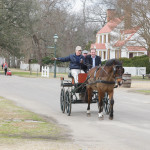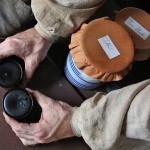
Our Tin Shop, with the assistance of some Historic Trades colleagues, recently delivered working 18th-century lamps for three of our carriages, making it easier for drivers and passengers to see and be seen.
And isn’t that the point of a carriage ride?
At the instigation of Director of Coach and Livestock Paul Bennett, our Historic Tradespeople in the Public Armoury were charged with manufacturing three pairs of lanterns to be mounted on the front corners of the Mulberry Phaeton, the Randolph Coach, and the Tucker Sociable. It was up to them to figure out how to do that in the most period-appropriate way possible.
The challenge? They’d never actually seen one.
In barely a month, they successfully researched, planned, manufactured, and delivered excellent work, as usual.
A Treatise on Carriages by London Coachmaker William Felton provided some very useful information about what lamps were fashionable on late-18th-century carriages. (Full title: A Treatise on Carriages; Comprehending Coaches, Chariots, Phaetons, Curricles, Whiskies, &c. Together with Their Proper Harness. In Which the Fair Prices of Every Article Are Accurately Stated.)
From this they learned that candles were the most common type of fuel (also, that the light was “frequently smothered… for want of sufficient openings at the bottom and top”).
Three styles were described by Felton: a globe lamp, an oval lamp, and an “Italian lamp, made long, but round in the body, and has the glass in three divisions.”
The globe and oval styles provided somewhat better illumination, but only to the road ahead. The Italian style had the benefit of casting some light in all directions, which was one factor in their choice to make that one. “We also had a series of photographs from an 18th-century chariot in Europe that had some scalable measurements,” explained Apprentice Tinsmith Joel Anderson, “so I was able to look at the photos and scale it up.”
But the photographs didn’t tell them how it was put together, and for that there was no substitute for getting to handle an original.
So in early September a small delegation—Joel, fellow Tinsmith Jenny Lynn, Blacksmith Mark Sperry, and Wheelwright Andrew De Lisle—trekked north to Mount Vernon to inspect two lamps associated with the Powell Coach, a carriage originally owned by George Washington. They were able to handle, measure, photograph, and even pull apart the assembly. Working outside-in, they needed to reverse engineer the lamp to discern the order of its original construction. (You might recall a similar journey undertaken a few months ago to inspect George Washington’s portfolio.)
The lamp on the Powell Coach was the globe style, but it was still tin-plated iron, the candle mechanism was the kind they were planning to replicate, and the assembly was the same as the European example.
Back in the Tin Shop Joel drew a schematic, worked out an assembly plan, and acquired the necessary materials. Only top-quality, period-appropriate materials were used, including reproduction tin-plated iron, hand-forged iron brackets, even handmade beeswax candles.
Much of the time was spent painstakingly cutting out all the individual pieces of tin. Each lamp has more than thirty distinct pieces.
There is a tube with a hand-made spring inside. The lamp’s candle sits down in the tube, with the coil applying continuous upward pressure, while the candle is held in place by a cap on top with a hole in the middle for the wick. As the candle melts, the spring keeps it in place even as it burns down to a nub.
Candles can be replaced by simply twisting and removing the bottom tube from below.
The Blacksmiths made a tool to punch the appropriate holes in the tin. The Tin Shop then made each individual punch by hand. Our Blacksmiths also made the mounts for the lamps, fashioning a clip mechanism to hold it to the body of the carriage. After slipping into the bracket, a leather belt made by the Artificer Shop keeps the lamp in place through a belt loop soldered onto the side of the tube that holds the candle.
Custom-made curved glass for the lamps is expected to be delivered soon. For the moment, we’re using temporary plastic panes.
These aren’t modern headlights, of course, and there are modest expectations for just how much the lights might illuminate the path ahead. The brightness depends on the fuel and the wick, and whatever reflective surface manages to enhance the reach of the light.
For the moment, we’re using LEDs, although the lamps are made to hold candles, and we have beeswax candles ready for that purpose. In his treatise, Felton derided the use of oil-burning lamps because they generated objectionable smoke and filth. While acknowledging that candlelight could be weak, he boasted of a “candle made of a superior composition,” available only in his shop at 36 Leather Lane, which shone brighter than any other then available.
Another upgrade is coming soon. It is expected that before the end of the year the lamps will be removed for painting. Most likely they will be painted black, but Al, a volunteer and paint-mixer-extraordinaire at the Wheelwright Shop, is experimenting with gold leaf that might at least provide some accents.
A carriage ride in Williamsburg is always special; now there’s a way to enjoy it even when the shadows are creeping and a chill is in the air. So bundle up and take an atmospheric evening ride. On Fridays and Saturdays, you can book one starting as late as 6:40 p.m.



Congratulations to your metal workers for their ingenuity and perseverance!